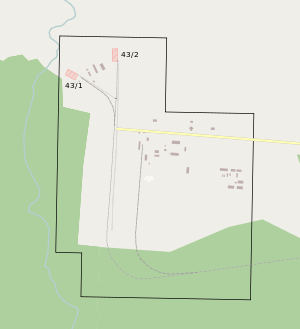Plesetsk Cosmodrome Site 43
 | |
| Launch site | Plesetsk Cosmodrome |
|---|---|
| Location | 62°55′12″N 40°28′1″E / 62.92000°N 40.46694°ECoordinates: 62°55′12″N 40°28′1″E / 62.92000°N 40.46694°E |
| Short name | Pu-43 |
| Operator | Russian Space Forces |
| Total launches | 497 |
| Launch pad(s) | Two |
| Site 43/3 launch history | |
| Status | Active |
| Launches | 214 |
| First launch | 21 December 1965 |
| Last launch | 2 November 2010 |
| Associated rockets |
R-7A Semyorka Vostok-2M Voskhod Molniya-M Soyuz-U Soyuz-2 |
| Site 43/4 launch history | |
| Status | Active |
| Launches | 283 |
| First launch | 25 July 1967 |
| Last launch | 25 December 2014 |
| Associated rockets |
R-7A Semyorka Vostok-2M Voskhod Molniya-M Soyuz-U Soyuz-M Soyuz-2 Soyuz-2-1v |
Site 43, also known as SK-3 and SK-4, is a launch complex at the Plesetsk Cosmodrome in Russia. It consists of a two pads, Sites 43/3 and 43/4, and has been used by R-7 derived rockets since the early 1960s.
The site was originally built for use by R-7A Semyorka missiles. The first launch to use the complex was an R-7A test on 21 December 1965, from Site 43/3. The first launch from 43/4 followed on 25 July 1967.
After its retirement from service as a missile base, it was converted for use as a space launch complex. The first orbital launch was of a Voskhod rocket with Kosmos 313 on 3 December 1969.
Both pads were damaged by explosions in the 1980s. At 16:01 GMT on 18 March 1980, 48 were killed when a Vostok-2M exploded during fueling operations at Pad 4. The disaster killed 50 people and injured dozens more, while damaging the pad so severely that it was not used again until 1984. On 18 June 1987, a Soyuz-U rocket exploded at liftoff on Pad 3.[1] Both were rebuilt, and are in service as of 2009.
References
- ↑ Wade, Mark. "Plesetsk". Encyclopedia Astronautica. Retrieved 2009-03-18.
- Zak, Anatoly. "Cosmodrome Plesetsk". RussianSpaceWeb. Retrieved 2009-03-18.
- Wade, Mark. "Plesetsk LC43/3". Encyclopedia Astronautica. Retrieved 2009-03-18.
- Wade, Mark. "Plesetsk LC43/4". Encyclopedia Astronautica. Retrieved 2009-03-18.
